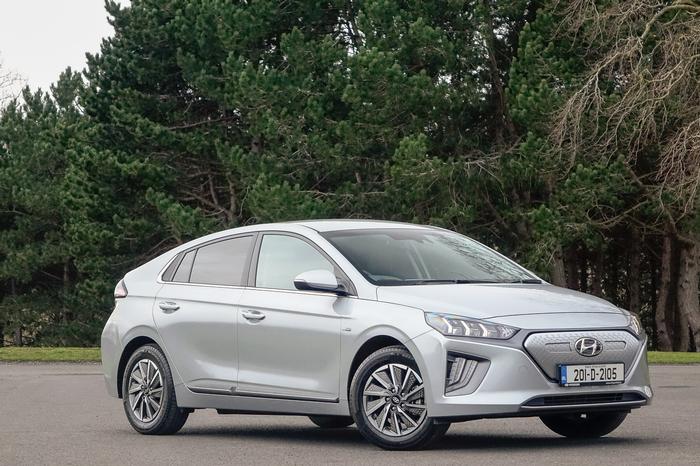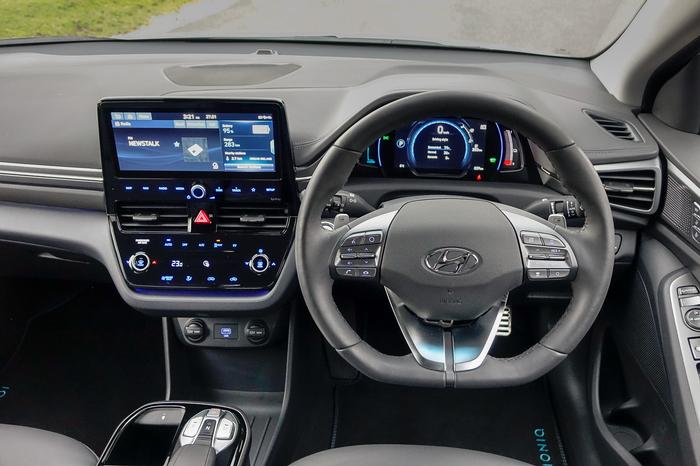Pros: Ease of use, equipment level, refinement
Cons: Quite small in the back and boot, range not great
Hyundai’s Ioniq is a five-door hatchback of about the same size as the company’s i30 model. It’s built on a different platform, though, one designed for electrification. There’s a plug-in hybrid version and an all-electric model, the latter tested here. Following on from its initial launch in 2016, the Ioniq came in for a round of updates last year, covering its design, equipment, safety and electric powertrain.
Hyundai Ioniq Design
When the Ioniq first appeared on the scene, we liked how it seemed to take on the Toyota Prius, but with a more coherent exterior design. The updates, however, make the Hyundai a bit, well, weirder, to look at, with a strange new set of 16-inch alloy wheels, redesigned bumpers and a blanked-off ‘grille’ up front. We do like the LED lights, however.

Hyundai Ioniq Interior
The interior wins more universal approval and the update brought with it restyled climate controls and a new touchscreen infotainment system. The screen measures 10.25 inches and, as ever with Hyundai, the menu system is a cinch to find your way around. Just as importantly, all the switchgear is well-damped and of high-quality feel. Up front, the Ioniq feels spacious enough, with plenty of oddments storage, though the rear seats and boot are not so generously proportioned. By way of comparison, the Hyundai i30 hatchback, which is shorter than the Ioniq, has a larger boot.

Hyundai Ioniq Performance & Drive
In isolation, the Ioniq Electric’s performance is more than adequate. The electric motor’s output peaks at the equivalent of 136hp and, as with all electric motors, maximum torque is available from a standstill, so the car gets off the line sharply. That’s especially the case if you choose the Sport driving mode. Not that there’s anything sporty about the way this car drives. It’s quiet and refined, which is what owners will want. We’d like it to be a fraction more comfortable at low speeds, though, as the suspension can feel a little firm over speedbumps and through urban potholes.
The Ioniq’s problem is that the Hyundai Kona crossover is available in electric format with a much longer range and more performance. Sure, it’s more expensive, but its electric system is far superior. For the record, Hyundai quotes a range of 312 kilometres for the Ioniq Electric (vs. 449km for the Kona Electric), and we achieved no better than 200km in our time with it over a mix of driving including some motorway.

Hyundai Ioniq Pricing
It’s quite simple. The Ioniq Electric is €34,850 including grants, while the Ioniq Plug-in Hybrid is €34,995. They’re both well-equipped, the price including niceties such as cruise control, heated and electrically folding door mirrors, electric windows all round, parking sensors and parking camera, keyless entry and start, part-leather heated seats, Bluetooth, smartphone mirroring and a lot more.
Carzone Verdict 3/5
While we’re not blown away by the Ioniq Electric, it is a polished product for those that want restrained hatchback styling in their EV. There’s enough of a price gap between it and the Kona Electric to justify its existence, and choice is a good thing.
Test Car Details:
Model driven: Hyundai Ioniq Electric
Price as tested: €34,850
Engine: electric motor
Transmission: automatic
Annual Motor Tax: €120
0-100km/h: 9.7 seconds
Power: 136hp
Boot space: 350 litres
